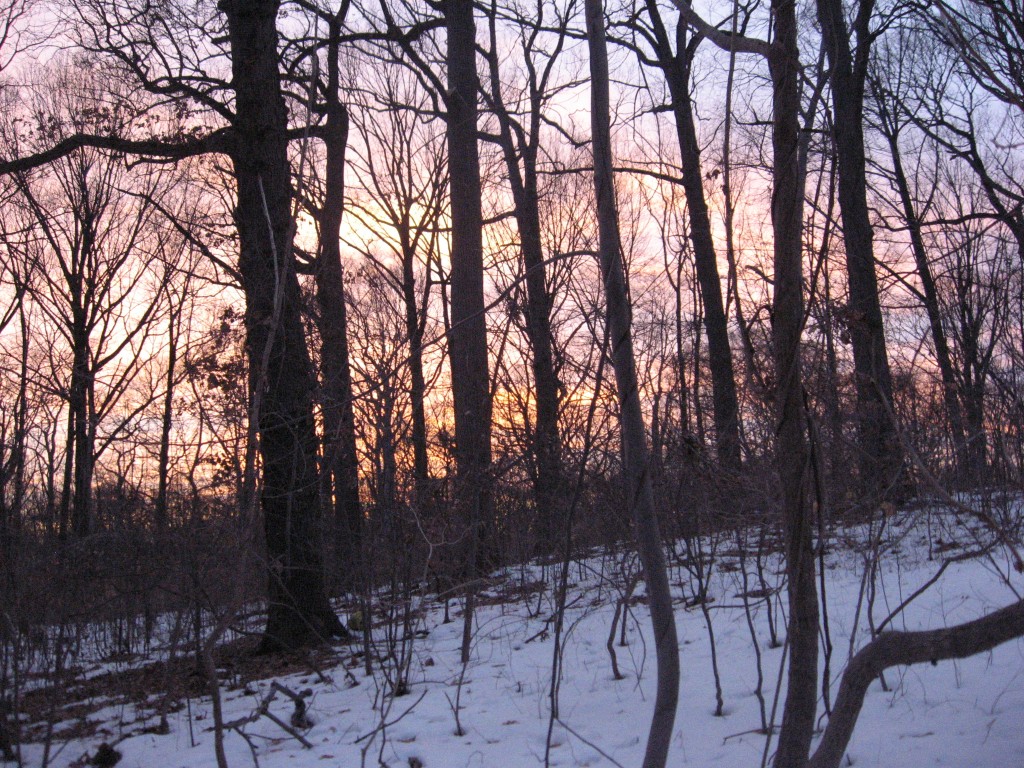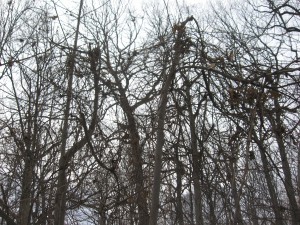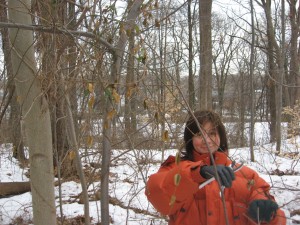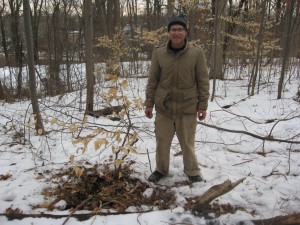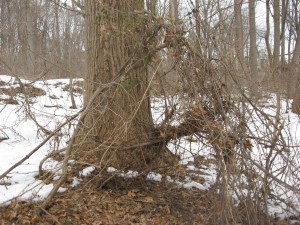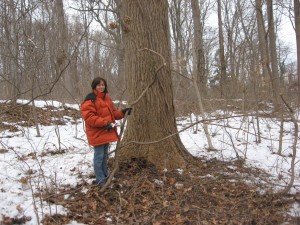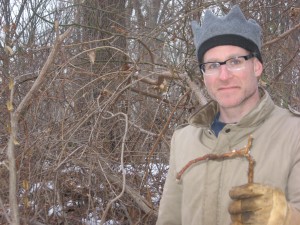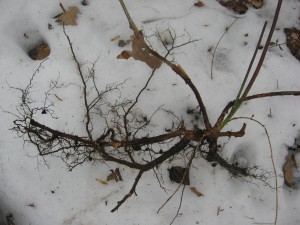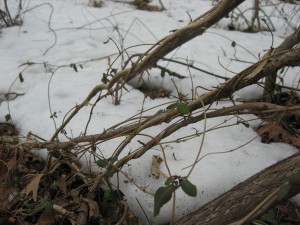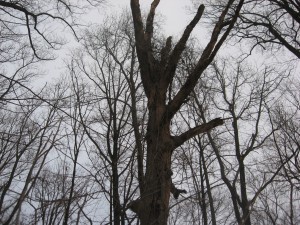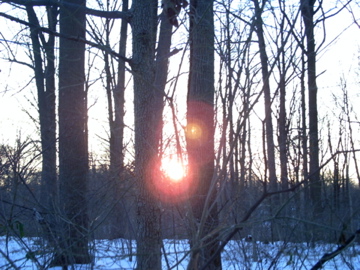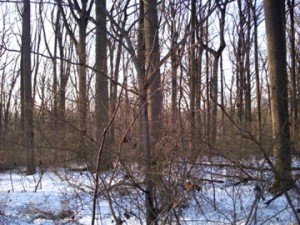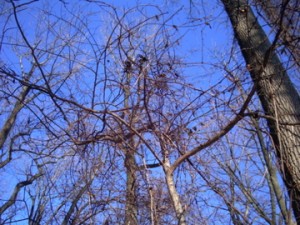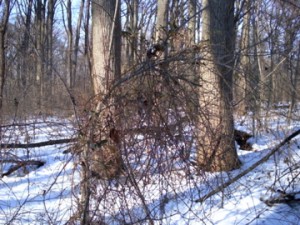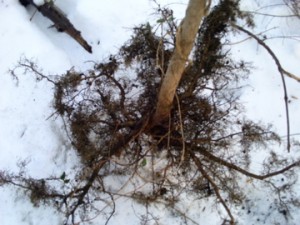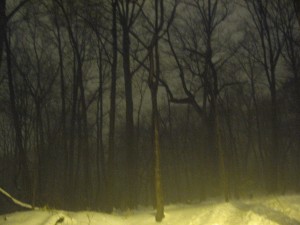DECADES OLD ORIENTAL BITTERSWEET INFESTATION BROUGHT DOWN; MULTIFLORA ROSE AND JAPANESE HONEYSUCKLE BROUGHT UNDER CONTROL
Morris Park- Â A dramatic turn of events unfolded this afternoon in this Beech-Oak upland forest of Morris Park, where the problematic “wall of invasives” was finally pulled down and bagged by a determined duo of local citizens. Â This momentous act that took 5 hours of hard work and filled 11 bags of material, completely changed the landscape. Â It was the first time this area looked like an eastern deciduous piedmont forest in years. Â The “wall of invasives” Â was an oppressive and impenetrable thicket of Oriental bittersweet, (Celastrus orbiculatus), Multiflora rose (Rosa multiflora), Japanese Honeysuckle (Lonicera japonica) and Burning Bush (Euonymous alatus).
Today was the culmination of 6 months of activities that led up the climactic fall of one of the most challenging groupings of invasives in the area. Â In August of 2010, many of these vines were cut at ground level. Â In November of 2010, work commenced removing all of the invasives around the wall, allowing full access to the site.
There was also a degree of planning as to how the execution of the exercise would proceed.  Due to the urgency of the vines on the trees, the local citizens decided on a “first pass” approach, which involves getting the vines off of the trees, first and foremost, and then coming back at a later time to remove the dense ground-layer matte of Japanese honeysuckle.  With a thick layer of snow on the ground, this made the most sense.  The snow also protects the dormant herbaceous plants that have buds close to the surface from being crushed by the feet of the pro-forest activists.
Isabelle Dijols, co-founder of the popular anti-exotic invasive pro-forest blog The Sanguine Root, was attacked earlier this afternoon by a falling section of the thorny vine Multiflora rose. Her thick winter coat and gloves saved her from possible injuries. Â She was asked about the great achievement of finally cutting down the “wall of Invasives” Â and where the forest was going to go from there:
” Right now I think it’s important to feel the jubilation and savor the moment. This has been a long and sometimes difficult process. Â Alot of work gloves were ruined, clippers worn dull, long hours were put in. Now we feel good about our work, tomorrow we plan for Morris park’s future. “
Sanguine Root’s blogger Sean Solomon was recently released from the tedious confinement of bagging Japanese Honeysuckle and Oriental Bittersweet. Â Back out on the open site, cutting down vines from a Dogwood tree, a much more glamourous exercise, he was asked about todays events: Sean waited for the birds to finish tweeting before he spoke.
“It’s great- It’s been a long time coming.  But it’s really just the beginning.  There’s going to be alot of follow-through necessary to effectively control the Japanese Honeysuckle.  We can’t just slap ourselves on the back, congratulate ourselves and have a party  every time we pull a weed. Were going to be going back to this site for a while, monitoring it, pulling more Japanese Honeysuckle, as well as seasonally controlling invasives such as Garlic Mustard  and the dreaded Mile-a-minute, more precisely Persicaria perfoliata, formerly polygonatum perfoliatum, which is growing only 75 feet from here.  I am humbled by this scope of work, and feel a great sense of pride when the neighbors show their appreciation.”
Mr Solomon also  noted that spell checks of all these latin names are very easy using the search engine Google.  He also noted that Facebook had nothing to do with today’s events.
A diversity of trees, the understory shrub Spicebush, and a host of herbaceous plants co-exist on the site. Â The trees include Oaks (Quercus), Beeches (Fagus grandifolia), Sweetgum (Liquidamber styraciflua), Sassafrass (Sassafrass albidum), Dogwood (Cornus florida), Tulip Poplar (Liriodendron tulipifera), and Black Cherry (Prunus serotina).
The herbaceous plants found in this exact site , to name a few, include Bloodroot (Sanguinaria canadensis), Mayapple (Podophyllum peltatum), Wild Geranium (Geranium maculatum), False Solomon’s Seal (Smilacina racemosa), Solomon’s Seal (Polygonatum biflorum), and what is believed to be, but not yet confirmed, Twisted Stalk.
Isabelle wanted to liberate this Sassafrass, but the task was daunting. She considered it for next time, but only for a fleeting moment. In this historical event for this specific site, the transformation is now. The wall must come down!
Well, then, of course, the next question arose: Is that little Sassafrass still alive? After some careful evaluation, sure enough, there was living tissue on the specimen, green shoots with buds on them, ready for spring!  It’s still alive!  Viva la  revolucion!
Isabelle proceeded to remove the Oriental bittersweet and Japanese Honeysuckle until the tree was liberated. After careful evaluation, the dead pale yellowish-tan branches were pruned off.
The most important thing was to get the vines down so the trees can grow, and not be strangled. Â Also the vines set leaves that block the sun and compete with the trees access to the needed sunlight for photosynthesis. Â Without enough sun, the trees can become weakened and eventually die. Â In this one site, there were many dead trees, including Sassafrass, Dogwood, and Spicebush (Lindera benzoin). It is sad when a dead tree is found under a thicket of invasive vines. Â As the day progressed and the events unfolded, the blighted urban wooded tract was transformed into a forested woodland area, with alot of interestingly shaped trees. Hopefully they will live and the ecosystem will mature and approximate the normalcy of a forest not infested with invasives.
The vision is that Morris Park will once again be a fully functioning Pennsylvania woodland, a forested piece of the great state and region we live in. Â With all of the invasives, Morris Park is at risk of being yet another degraded forest remnant of the urbanized Philadelphia region, an ecologically diminished mess of dead trees and aggressive vines next to a densely populated area. Â That would be a shame and hopefully will not happen under the watch of so many concerned citizens in our neighborhood and the city at large. Â Morris Park has so many features of a southeastern Pennsylvania woodland still existing and thriving that it is a natural treasure. To be able to walk out of one’s front door and into a bonified Pennsylvania forest, right here in the city of Philadelphia, is something we can still be proud of and we intend to keep it that way.



